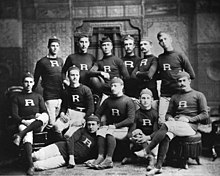As was the case in Britain, by the early 19th century, North American schools and universities played their own local games, between sides made up of students. Students at Dartmouth College in New Hampshire played a game called Old division football, a variant of the association football codes, as early as the 1820s.

The "Tigers" of Hamilton, Ontario, circa 1906. Founded 1869 as the Hamilton Foot Ball Club, they eventually merged with the Hamilton Flying Wildcats to form the Hamilton Tiger-Cats, a team still active in the Canadian Football League.[82]
In 1869, the first game played in the United States under rules based on the FA code occurred, between Princeton and Rutgers. This is also often considered to be the first U.S. game of college football, in the sense of a game between colleges (although the eventual form of American football would come from rugby, not association football).
Modern American football grew out of a match between McGill University of Montreal, and Harvard University in 1874.[83] At the time, Harvard students are reported to have played the Boston Game — a running code — rather than the FA-based kicking games favoured by U.S. universities. This made it easy for Harvard to adapt to the rugby-based game played by McGill and the two teams alternated between their respective sets of rules. Within a few years, however, Harvard had both adopted McGill's rugby rules and had persuaded other U.S. university teams to do the same. In 1876, at the Massasoit Convention, it was agreed by these universities to adopt most of the Rugby Football Union rules, with some variations. Princeton, Rutgers and others continued to compete using soccer-based rules for a few years before switching to the rugby-based rules of Harvard and its competitors. U.S. colleges did not generally return to soccer until the early 20th century.
In 1880, Yale coach Walter Camp, devised a number of major changes to the American game. Camp's two most important rule innovations in establishing American football as distinct from the rugby football games on which it is based are scrimmage and down-and-distance rules.
Scrimmage refers to the practice of starting action by delivering the ball from the ground to another player's hand. Camp's original rule allowed this delivery to be done only with the feet; the rule was soon changed to allow the ball to be passed by hand. The rule also established a distinct line of scrimmage which separates the two teams from each other. When a player is tackled, he is ruled down and play stops, while the teams reset on either side of the line of scrimmage. Play then resumes with the delivery of the ball. Teams are given a limited number of downs to achieve a certain distance (always measured in yards). In American football, teams are given four downs to advance the ball ten yards, after which possession of the ball changes. In Canadian football, teams are allowed three downs to advance ten yards. These rules created a fundamental distinction between the North American codes and rugby codes. Rugby is still fundamentally a continuous-action game, while North American codes are organized around running discrete "plays", as defined as starting with the delivery from "scrimmage" and ending with the "down".

Tidak ada komentar:
Posting Komentar